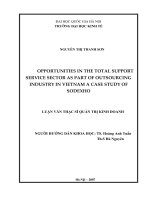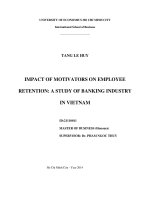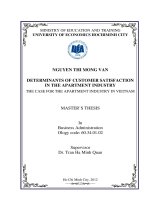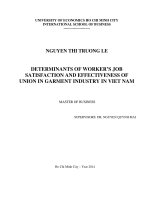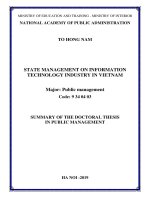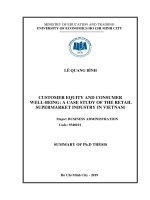shortage of gasoline industry in vietnam eco111 group assignment written report
Bạn đang xem bản rút gọn của tài liệu. Xem và tải ngay bản đầy đủ của tài liệu tại đây (7.1 MB, 37 trang )
<span class="text_page_counter">Trang 1</span><div class="page_container" data-page="1">
<small>SHORTAGE OF GASOLINE INDUSTRY IN VIETNAM</small>
ECO111 GROUP ASSIGNMENT WRITTEN REPORT
<b> </b>
<b> Class: MKT1801 – Group 1 </b><small> 1. Nguyễn Hồng Minh Hịa - SS170059 2. Võ Minh Hoàng – SS170825</small>
<small> 3. Đặng Cao Thức – SE170045 4. Trương Tuyết Mai – SS181325 5. Lê Kim Hạnh Tiên – DS180304 6. Đoàn Thái Hà – SS181365 </small>
</div><span class="text_page_counter">Trang 2</span><div class="page_container" data-page="2"><b><small>I. Introduction... 1</small></b>
<b><small>II. Microeconomics and Resources Basics... 2</small></b>
<b><small>III. Oil shortage in Vietnam... 3</small></b>
<b><small>IV. Factors affecting oil supply in Vietnam... 6</small></b>
<b><small>V. Factors affecting oil demand in Vietnam... 17</small></b>
<b><small>VI. Impact of oil shortage in Vietnam... 23</small></b>
<b><small>VII. Solutions and policies to mitigate the oil shortage... 27</small></b>
<b><small>VIII. Conclusion... 31</small></b>
<b><small>IX. References... 32</small></b>
<b>I. Introduction </b>
<b>A. Overview of oil shortage in Vietnam </b>
Vietnam is a country which is heavily reliant on imported oil to meet its energy needs and as a result, the country has experienced periodic shortages and price hikes in recent years. However, in this recent month in Viet Nam, many economic experts insist that the petroleum market has returned to be normally, supply and demand are guaranteed will decrease to the end of the year; however, it is forecasted that by the end of 2023, Vietnam's petroleum market will face with many uncertainties. There are many factors that directly affect the shortage of oil in Vietnam such as Economic, Demand Supply, The world market,... The current situation of lack of oil has greatly affected the lives of people and businesses, so the government is still trying its best to solve this problem, but in the immediate future, it has not yet achieved the desired effect.
</div><span class="text_page_counter">Trang 3</span><div class="page_container" data-page="3"><b>B. Purpose and scope of the report</b>
The impact of the shortage of oil
Studies related to the shortage of petroleum in Vietnam and the results achieved in solving this problem.
<b> . Microeconomics and Resources Basics </b>
<b>A. The definition and role of microeconomics </b>
Microeconomics is the branch of economics that studies the behavior and decisions of individuals, households, firms, and markets in relation to the allocation of scarce resources.
</div><span class="text_page_counter">Trang 4</span><div class="page_container" data-page="4">Resources are all things that can be used to create products and services that meet the wants and needs of people. Resources can be classified into four categories: land, labor, capital, and entrepreneurship.
<b>B. Basic concepts related to resources</b>
Supply is the amount of a good or service that producers are willing and able to offer for sale at various prices during a given period of time.
Demand is the volume of a good or service that customers are willing and able to buy at different prices throughout a specific time period.
Price is the amount of money that buyers pay to acquire a unit of a good or service.
<b>III. Oil shortage in VietnamA. Oil use and export situation</b>
Vietnam is a net oil importer, meaning that it consumes more oil than it produces. In 2021, Vietnam exported about 3.1 million tons of crude oil, down by 32.8% from 2020, while it imported about 9.9 million tons of crude oil, up by 4.5% from 2020 (CEIC Data, 2022; VietnamNet, 2022)
Vietnam mainly exports its crude oil to Thailand, Australia, and China, while it imports crude oil from Kuwait, Malaysia, Brunei, Russia, and other countries (S&P Global Platts,2022; CEIC Data, 2022).
Vietnam also imports refined petroleum products such as gasoline, diesel, jet fuel, and liquefied petroleum gas (LPG) to meet its domestic demand. In 2021, Vietnam imported about 15.6 million tons of refined petroleum products, up by 11.4% from 2020 (General Department of Customs, 2022).
</div><span class="text_page_counter">Trang 5</span><div class="page_container" data-page="5"><b> Causes of the shortage of oil</b>
One of the main causes of the shortage of oil in Vietnam is the decline in domestic production due to the depletion of existing oil fields and the lack of new discoveries and investments (S&P Global Platts, 2022; The Journal of International Trade & Economic Development, 2020).
Another cause is the disruption in the operation of Nghi Son Refinery and Petrochemical (NSRP), the largest refinery in Vietnam with a capacity of 200,000 barrels per day (bpd), due to technical issues and financial difficulties. NSRP has been running at below 50% capacity since November 2021 and may shut down completely in February 2022 if it failsto secure funding from its shareholders (Business Insider, 2021; Viet Nam News, 2022).A third cause is the increase in global oil prices and demand due to the recovery from the COVID-19 pandemic and the supply constraints from OPEC+ countries. This has made oil imports more expensive and competitive for Vietnam (S&P Global Platts, 2022; The Journal of International Trade & Economic Development, 2020).
</div><span class="text_page_counter">Trang 6</span><div class="page_container" data-page="6"><b>C. Consequences of Oil Shortage</b>
One of the consequences of the oil shortage in Vietnam is the rise in domestic fuel prices and inflation. According to the General Statistics Office, the consumer price index (CPI) increased by 3.08% year-on-year in December 2021, mainly driven by the transport sector which rose by 12.64% due to higher fuel costs (General Statistics Office, 2022).Another consequence is the closure of some gas stations and the rationing of fuel supplies for customers. Some gas stations have reported running out of gasoline or diesel due to delays or cancellations in deliveries from suppliers. Others have limited the amount of fuel that customers can buy or increased their prices above the regulated ceiling (Business Insider, 2021; Viet Nam News, 2022).
A third consequence is the negative impact on economic growth and trade balance. Oil is an essential input for many sectors such as manufacturing, transportation, agriculture, andelectricity generation. A shortage of oil could reduce output, employment, income, and exports in these sectors. Moreover, a higher dependence on oil imports could widen the trade deficit and put pressure on the exchange rate and foreign reserves (The Journal of International Trade & Economic Development, 2020).
</div><span class="text_page_counter">Trang 7</span><div class="page_container" data-page="7"><b>IV. Factors affecting oil supply in VietnamA. Geologic and technical factors1. Reservoir quality and size</b>
Effective reservoir management are crucial for maintaining a steady oil supply. This involves monitoring reservoir conditions, optimizing production strategies and implementing techniques to minimize reservoir deterioration. Specifically, higher porosity and permeability reservoirs tend to have better oil recovery. Besides, the size of the oil reservoir determines its overall oil potential. Large reservoirs are capable of producing more oil over an extended period.
</div><span class="text_page_counter">Trang 8</span><div class="page_container" data-page="8"><b>2. Geological structure</b>
The presence of structural features can affect the distribution and accessibility of oil reserves. Complex geological structures make it more challenging to extract oil efficiently.
<b>3. Exploration and production technology</b>
The use of advanced machinery and techniques can improve the discovery and extractionof oil reserves. Technological advances in production methods have significantly improved oil recovery rates in Vietnam.
</div><span class="text_page_counter">Trang 9</span><div class="page_container" data-page="9"><b>4. Infrastructure</b>
The availability of infrastructure, including pipelines, refineries and storage facilities is critical for the transportation and handling of extracted oil since adequate infrastructure facilitates efficient oil production and delivery.
</div><span class="text_page_counter">Trang 10</span><div class="page_container" data-page="10"><b>5. Expertise and human resources</b>
The availability of skilled personnel with expertise in oil exploration, production and management plays a vital role in ensuring efficient operations and maximizing oil recovery. Qualified and well-trained personnel can ensure safe and optimal oil extraction,supporting a stable oil supply.
<b>B. Oil extraction and production process1. Production efficiency</b>
</div><span class="text_page_counter">Trang 11</span><div class="page_container" data-page="11">The efficiency of the oil extraction and production process has a significantly impact on the rate of production. Efficient processes can maximize oil recovery from reservoirs, thereby increasing the overall supply. In addition, advanced techniques and enhanced oil recovery methods can further improve production efficiency.
<b>2. Maintenance</b>
Regular maintenance of oil production facilities is essential to avoid operational disruptions. Adequate investments in infrastructure, including wells, pipelines and processing plants, help prevent production downtime and ensure a continuous supply of oil.
</div><span class="text_page_counter">Trang 12</span><div class="page_container" data-page="12"><b>3. Technology</b>
Technological advances play an important role in optimizing oil production and extraction processes. The application of advanced techniques and real-time monitoring systems can improve operational efficiency and increase oil supply.
<b>4. Environment considerations</b>
</div><span class="text_page_counter">Trang 13</span><div class="page_container" data-page="13">Environmental policies and regulations can affect oil production operations. Compliance with environmental regulations, such as proper waste management and minimizing ecological impacts, is necessary to maintain operating permits and avoid production disruptions.
<b>C. Policies and regulations1. Licensing</b>
The licensing process ensures that only qualified companies can operate in the oil sector, maintaining environmental safety standards. These regulations affect the number of companies involved in oil exploration and thus the overall oil supply potential.
</div><span class="text_page_counter">Trang 14</span><div class="page_container" data-page="14"><b>2. Production quotas</b>
The government can establish production quotas for oil companies to ensure sustainable exploitation and prevent the depletion of oil reserves. By controlling production levels, the government can manage oil supplies and maintain market stability.
</div><span class="text_page_counter">Trang 15</span><div class="page_container" data-page="15"><b> Environmental regulations</b>
Policies and regulations related to environmental protection can impact oil supplies. Stringent regulations regarding pollution control, waste management and environmental impact assessment may require oil companies to invest in technology to minimize their impact on the environment. These regulations can affect production costs and in turn, influence oil supply.
<b>4. State-owned enterprises</b>
Vietnam has state-owned oil and gas companies that are important in the oil sector. Government policies and regulations governing the operations of these state-owned enterprises, including their production levels and investment decisions, have a significantimpact on the overall oil supply.
</div><span class="text_page_counter">Trang 16</span><div class="page_container" data-page="16"><b>5. Taxation</b>
Tax-related policies can affect oil production and supply. Governments can offer tax incentives or subsidies to encourage production and investment in the oil sector. Tax policies also influence the cost of imported oil, shaping the competitiveness of the domestic oil and gas industry and affecting the overall supply situation.
</div><span class="text_page_counter">Trang 17</span><div class="page_container" data-page="17"><b>6. Energy security</b>
Government energy security goals can shape oil supply policies. Vietnam's government should impose policies to diversify its energy sources and reduce dependence on oil. These policies could encourage the development of alternative energy sources, which could affect long-term oil supplies.
</div><span class="text_page_counter">Trang 18</span><div class="page_container" data-page="18"><b>V. Factors affecting oil demand in Vietnam </b>
<b>A. Economic development and population growth</b>
- Economic development
According to the Report, Vietnam's economy is predicted to rise by 6.5% in 2023 and 6.8% in 2024 after 2022 came to a successful conclusion. The Asian Development Bank (ADB) publishes the Asian Development Outlook (ADO). The domestic production activities will increase as Vietnam's economy grows, which would raise the need for petroleum.
- Population growth
Vietnam's population is expected to surpass 100 million in the not too distant future, moving it up to the position of the world's 15th most populous nation. With a population of 100 million, there is a sizable domestic market and greater potential for luring foreign direct investment due to the abundance of human resources. The urge for travel among
</div><span class="text_page_counter">Trang 19</span><div class="page_container" data-page="19">people is also growing every day. In order to support Vietnam's transportation, export, and production needs, there was a rise in the need for petroleum at that time.
Graph and table of Vietnam's population from 1950 to 2023. United Nationsprojections are also included until 2100.
<b>B. Petroleum-using industries</b>
In Vietnam, the following sectors use the most oil
<b>Transportation and Logistics Sector: The oil consumption of the Vietnamese </b>
transportation and logistics sector is among the highest. The engines of vehicles, trucks, boats, motorbikes, and airplanes are frequently fueled with gasoline.
</div><span class="text_page_counter">Trang 20</span><div class="page_container" data-page="20"><b>Manufacturing: Petroleum is a key energy source in the processing of materials such as </b>
steel, cement, wood, chemicals, plastics, rubber, and other materials.
</div><span class="text_page_counter">Trang 21</span><div class="page_container" data-page="21"><b>Agriculture: In the agricultural industry, petroleum is used to power machinery, </b>
equipment, construction machinery, and irrigation systems.
<b>Power sector: The production of electricity in power plants uses fuels such as fuel oil </b>
and diesel, especially in areas not connected to the national grid.
</div><span class="text_page_counter">Trang 22</span><div class="page_container" data-page="22"><b>Tourism and service industry: The tourism and service industry also consumes a large </b>
amount of fuel such as gasoline in the operation of tourist vehicles and restaurants and hotels.
<b>Chemical industry: To create a variety of chemical products, chemical manufacturing </b>
facilities utilize a lot of petroleum as a raw material.
</div><span class="text_page_counter">Trang 23</span><div class="page_container" data-page="23"><b>Oil and gas industry: The oil and gas industry, which entails the extraction and </b>
production of oil and gas, makes extensive use of oil in these processes.
<b>Construction sector: During construction, the industry uses a lot of energy, including </b>
gasoline for tractors, compressors, excavators, and other machinery.
</div><span class="text_page_counter">Trang 24</span><div class="page_container" data-page="24"><b>C. Changes in alternative sources of supply</b>
The demand for petroleum tends to fall in some areas, including transportation, as a resultof consumers switching to alternate energy sources like electricity, ethanol, propane, etc since fuel is becoming increasingly scarce.
<b>VI. Impact of oil shortage in Vietnam A. Impact on prices and inflation</b>
The cost of imported materials makes up 37% of the entire cost of raw materials across the economy in Vietnam, a country that is heavily dependent on imports. A rise in the price of gasoline on a worldwide scale would increase the cost of domestic and imported raw materials. (Vietnam Law Magazine, 2022)
More or less, most industries use gasoline. 3.52 percent of the overall production expenses across the economy are attributed to the cost of gasoline. This indicates that gasoline has a significant impact on production costs and accounts for a sizable amount of them. Notably, rising fuel prices will have a significant impact on gasoline-intensive businesses like fishing and transportation. (Vietnam Law Magazine, 2022)
Inflationary pressure, decreased competitiveness of local goods, and price increases for commodities in circulation are all negative effects of rising gasoline prices that also have an adverse impact on economic growth. (Vietnam Law Magazine, 2022)
There is a significant negative impact of fuel prices on economic growth in Vietnam, where a 10% increase in petrol prices would cause the GDP to fall by almost 0.7%.
(Vietnam Law Magazine, 2022)
</div><span class="text_page_counter">Trang 25</span><div class="page_container" data-page="25"><b> Impact on productivity and economic competition</b>
1 . The cost of gasoline is challenging for transportation companies
The industry most vulnerable to changes in the price of gasoline is road transportation. Typically, the cost of gasoline makes about 35–40% of the total cost of road
transportation. There are periods when fuel expenditures represent a very high percentageof transportation costs—up to 40–45% for the most expensive mode of transportation, theroad—due to the corresponding rise in gas prices.
2 . Difficult for economic and productivity
Indirectly for any other enterprises that have demands. Directly for people, businesses, and industries that consume petroleum products, such as road transportation, fishing,
</div>
